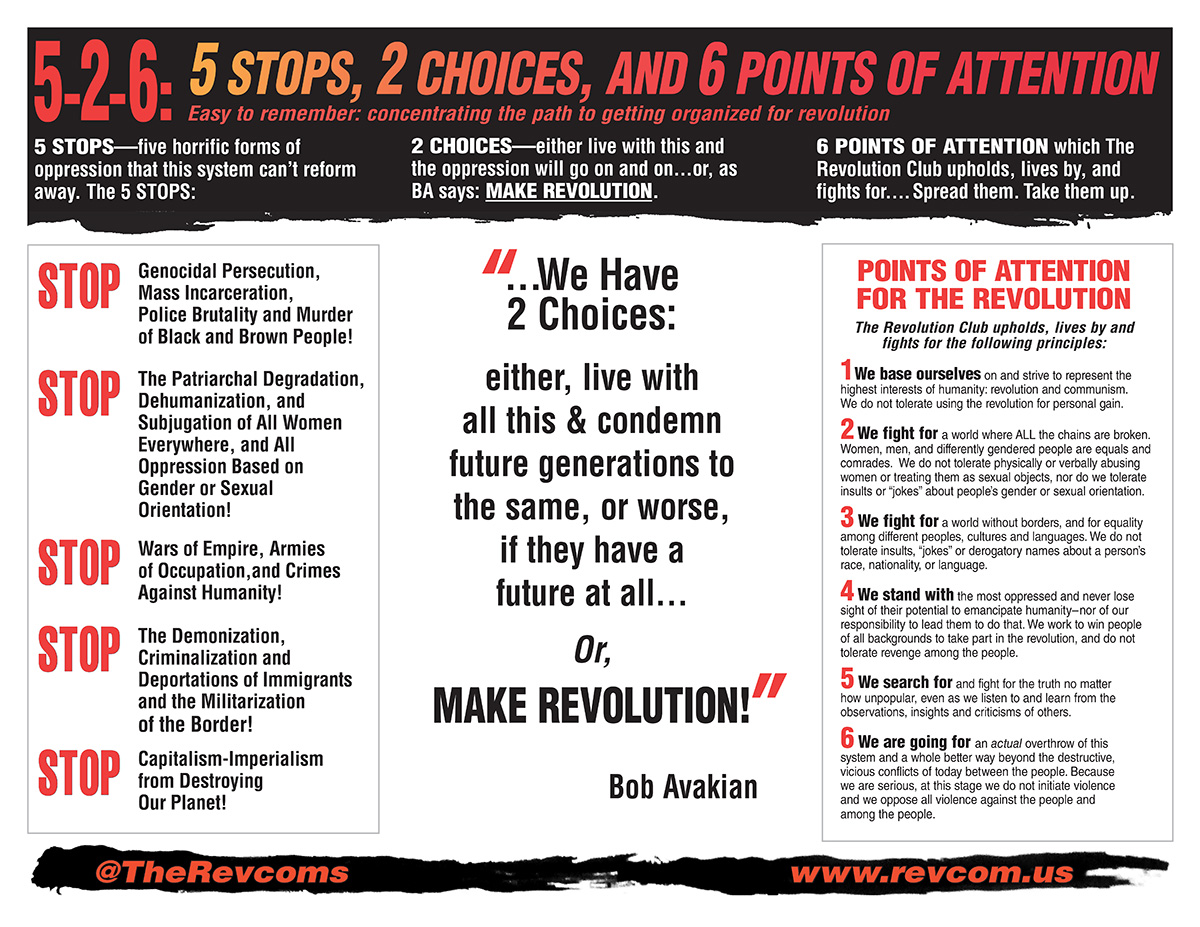Speech by Rafael Kadaris at the Revolution Books Panel Discussion
| revcom.us
What’s up, everyone! I’m really excited to be here, to be part of this important discussion with all these panelists, and I’m really eager to hear from all of you in the Q&A.
I’ve actually been in LA the last few months as part of the national tour organizing for revolution. And while I was down there I had a chance to see another controversial mural.
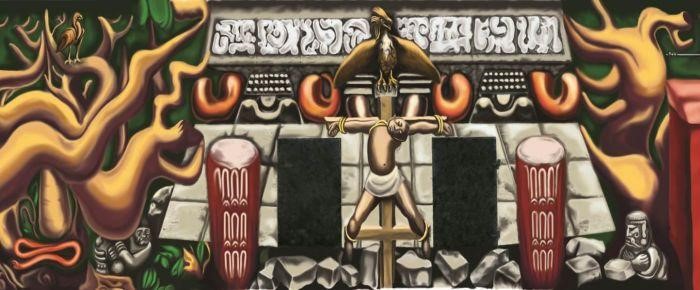
“Tropical America—oppressed and destroyed by imperialism.” 1932 by David Siqueiros
It’s called “Tropical America—oppressed and destroyed by imperialism.” Painted in 1932 by the great Mexican muralist David Siqueiros, who I believe Dewey worked with at one point. It’s on Olvera Street, which, if you haven’t been there, is sort of a quaint, idealized version of a Mexican marketplace for tourists, and in the 1930s was part of marketing LA for new homebuyers, as a colorful and romantic place with an ethnic past, but safe for white people. So in the same way that Arnautoff was commissioned to paint a nice, benign mural on the “Life of George Washington,” they commissioned Siqueiros to do a mural on the theme of “Tropical America”—expecting him to do a scene with parrots and palm trees and happy tropical people drinking coconuts. And this is what he did—as you can see, right in the middle of it, an indigenous person is crucified by an American eagle. As you can imagine, this scandalized the Olvera Street business people, who did not want THIS image to disturb the tourists, and pretty soon they whitewashed the whole thing. Luckily, thanks to the LA smog, the whitewash started wearing off in the late 1960s and the mural started reappearing and has since been preserved. But look at this mural and think about this story and tell me what’s the difference here. Or do you think this one should’ve been painted over too?
Now think about the title of that mural, “Tropical America—oppressed and destroyed by imperialism.” Flash forward from 1932, from the banana republics and dictatorships set up in Central America by the U.S., the coups and invasions, the U.S.-backed death squads, the made-in-the-USA poverty and gang violence, the drought caused by climate change, and look at the situation now, where the refugees from tropical America, oppressed and destroyed by imperialism, are called rapists, drug dealers, and animals, and if they don’t die in the desert, or drown in the Rio Grande, or get gunned down by some mass murdering vigilante inspired by Trump, they are chased down by modern-day slave catchers, thrown in concentration camps, and treated worse than dogs. And the Democrats, who helped to create this situation in the first place, are doing nothing about this, besides giving Trump $4.6 billion for ICE and Border Patrol.
So yes, as the quote from Bob Avakian on the wall says, “Let’s get down to basics: We need a revolution. Anything else, in the final analysis, is bullshit.” The tour that I’ve been part of is traveling the country organizing the thousands who need to become leaders of the millions to make this revolution.
As this message from the national tour makes clear, all of this horrible oppression, these 5 STOPS—the white supremacy, the patriarchy and attacks on immigrants, the imperialist wars and destruction of the environment—are built into this system, and as Bob Avakian puts it, “[W]e have two choices: either, live with all this—and condemn future generations to the same, or worse, if they have a future at all—or, make revolution!” And then it goes on to talk about what kind of world we’re fighting for and how do you live today in a way that’s part of getting to that world.
The whole way of thinking embodied in the campaign to destroy these murals, as I’ll get into more, is a big obstacle to making the revolution we need and getting to a different world, a big obstacle to confronting reality and acting to change it radically.
And right now, especially in this moment, as fascism is consolidating and white supremacy is on the offensive, do people need to be disturbed, “triggered,” pushed outside their comfort zone, and compelled to act? And yes, to take risks and make sacrifices to stop all this?
Do they need to hear the cries of the kids in Mississippi after coming home from their first day of school to find out their parents were kidnapped by ICE? Or should they turn away from it like the “good Germans” who did nothing while their Jewish neighbors were rounded up? And here it is important to add a painful but historical fact, that despite heroic resistance by Jewish fighters in the Warsaw ghetto and some other places, most Jews also failed to act until it was too late. And one of the reasons for this was the Jewish community leaders who hid the truth about the death camps, about where the trains were taking people, because they didn’t want to upset people.
So I have to say, the idea of creating “safe spaces” where people can be sheltered from anything traumatic is just bullshit. First of all, it’s an illusion. Look at what’s happening in the world—the Amazon’s on fire, the Arctic is melting, and there’s an open white supremacist fascist with the nuclear codes—you can’t keep people in a bubble from all that. Trigger warnings and safe spaces are completely useless against the actual powers that be and what they intend to do to people. Second, it’s condescending and paternalistic as hell. Let these youth look at the world, and history, and decide for themselves what they think about it. Lastly, it’s teaching people that the most important thing is taking care of yourself and being comfortable, which is just a gross individualistic way to live your life, especially in a country like this, where the ability and privilege for some people to ignore uncomfortable truths is based on the oppression and exploitation and, yes, trauma inflicted on people around the world.
Here I want to read two very relevant quotes from BAsics, by Bob Avakian.
“Oppressed people who are unable or unwilling to confront reality as it actually is, are condemned to remain enslaved and oppressed.”
“There is a place where epistemology and morality meet. There is a place where you have to stand and say: It is not acceptable to refuse to look at something—or to refuse to believe something—because it makes you uncomfortable. And: It is not acceptable to believe something just because it makes you feel comfortable.”
And speaking of uncomfortable truths, let’s talk about the founding fathers.
Apparently, the people who want to whitewash the mural have no problem sending kids to a school named after George Washington but they don’t want them to find out the monster that he was, and the monstrous country that he founded. They have no problem with the big bronze statue of him at the school. They have no problem with the panel featuring Washington, Jefferson, and Hamilton discussing a draft of the U.S. Constitution—a constitution that institutionalized slavery, a constitution that still enables the rulers of this system to commit horror upon horror against people, while doing it all in the name of “We the people.”
As I said in the article I wrote, if anything, Arnautoff is too soft on Washington. (Here I’ll just refer you to the very important American Crime series, of the 100 greatest crimes committed by the U.S. government, that you can find on revcom.us, which includes an indictment of Washington’s role in the Sullivan expedition, where he ordered a scorched earth campaign of total annihilation against over 50 Iroquois villages in New York State.)
Now, some of the people that want to “paint it down” might say that everyone already knows the U.S. was founded on slavery and genocide, so there’s no need to keep looking at it. Well, actually everyone doesn’t already know that. One of our bookstore staff did an informal poll at UC Berkeley yesterday and was surprised by how few students (at the #1 public university in the country) even knew Washington was a slave owner! And people certainly don’t know the horror of slavery. For example, the average lifespan of a slave working on a sugar plantation was seven years, because they were literally worked to death.
And among those who know on one level about crimes of this country, there is a stubborn refusal to confront that this country is rotten to the core and can’t be redeemed. A clinging to the narrative, the same narrative people like Obama tell, that, yes, slavery was an original sin, but America was founded on great democratic ideals which have helped us steadily overcome racism in the onward march of progress. No, in fact America has never been great, and the democratic ideals, the Constitution and laws, the dominant culture, have always served to reinforce this system of exploitation and oppression, from slavery, to Jim Crow, and down to the present.
To illustrate this contrast... what is the “positive” image the school board president suggested to replace the Arnautoff murals? Black soldiers fighting in Washington’s army. So, a mural depicting Black people (many of whom, by the way, were still enslaved) fighting for the “freedom” of a bunch of capitalists and slave owners is positive and uplifting imagery for Black students?! C’mon. People like this should just be honest... they want to destroy the mural because they believe in America and its promise. They think that if you just move forward and focus on the positive—like Jay Z said about Colin Kaepernick, “we’re past kneeling”—you can make it in America and get a seat at the table.
On that note, here’s a few questions to think about and dig into more in the Q&A. Should the goal be to get a seat at the table, or to overturn the table and make a revolution? Do oppressed people need consolation, or do they need liberation? Owning oppression, or ending oppression? Getting in on this system, or getting rid of this system?
Lastly I want to address one of the elephants in the room. Who has a right to speak? Who has the right to make art? As we know, one of the main criticisms of the murals is that since Arnautoff was a white man, he had no right to depict the experiences of Black people or Native Americans, or at least he should’ve asked their permission first. First of all, it must be said that almost no art could be made with this criteria. Most of the books in this room, which deal with all kinds of subjects beyond the authors’ personal, direct experience, and certainly all the fiction, would have to go. But there’s another question: Whose permission should he have asked? All Black and Native people don’t think the same way. And anyway, people aren’t always right just because they’re oppressed. As we know, there were Cherokee who owned slaves, and there were Black “buffalo soldiers” who went out West and slaughtered Native people. There were tribes who fought on both sides of the Civil War.
All this points to the more fundamental thing, which is that there is one objective reality, and anyone can come to understand it. Truth does not vary depending on how oppressed someone is. People who’ve directly experienced oppression should be heard. But direct experience alone doesn’t tell you what the root cause of that oppression is, or how it can be ended. In fact, this whole approach of standpoint epistemology (the idea that truth depends on people’s socio-economic “standpoint”) is a major barrier to getting a deeper understanding of the underlying dynamics of society and how it can be changed.
So no, the problem is not a white artist who, with all his limitations (and we can talk more about that in the Q&A), did paint a mural with subversive and anti-racist content. And the fact that some people made a whole campaign to target this mural, and not the statue of Washington—the actual monument to slavery hiding in plain sight at the school—or the actual white supremacists who are in power and fomenting a new civil war... that should tell you everything you need to know about the harm that identity politics does and how it lets the system off the hook.
We do need more resistance art, more revolutionary art to uplift and inspire people, especially the youth... not with a bunch of hyped up “yes we can” American dreaming... but with an actual positive vision of a different way things can be... but for that culture to really blossom, there has to be a lot more resistance and revolution!
So let me end with what is on the wall of this bookstore:
3 Things that have to happen in order for there to be real and lasting change for the better:
1) People have to fully confront the actual history of this country and its role in the world up to today, and the terrible consequences of this.
2) People have to dig seriously and scientifically into how this system of capitalism-imperialism actually works, and what this actually causes in the world.
3) People have to look deeply into the solution to all this.—Bob Avakian, May 1, 2016
Video of the “Life of George Washington Mural” Panel Discussion at Revolution Books Berkeley, 8-22-19
See also:
- Packed House at Revolution Books for Panel Discussion on “Life of George Washington” Mural Controversy: Art, politics, the “founding fathers” and what it will take to get beyond this world of oppression
August 26, 2019 - Identity Politics Hustlers Sanitize “Life of George Washington”
July 22, 2019 - Responses to Revcom’s Polemic: “Identity Politics Hustlers Sanitize the ‘Life of Washington’”
July 29, 2019
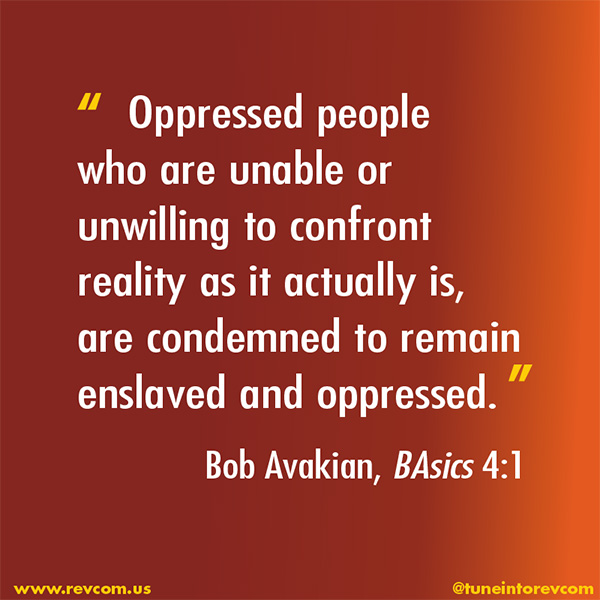
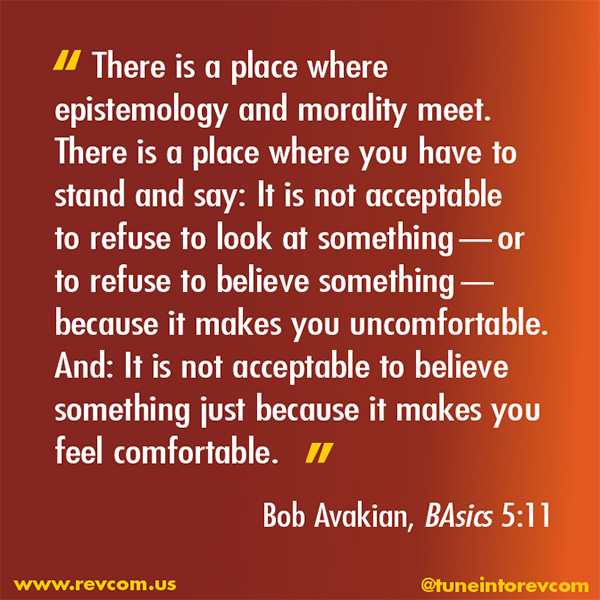
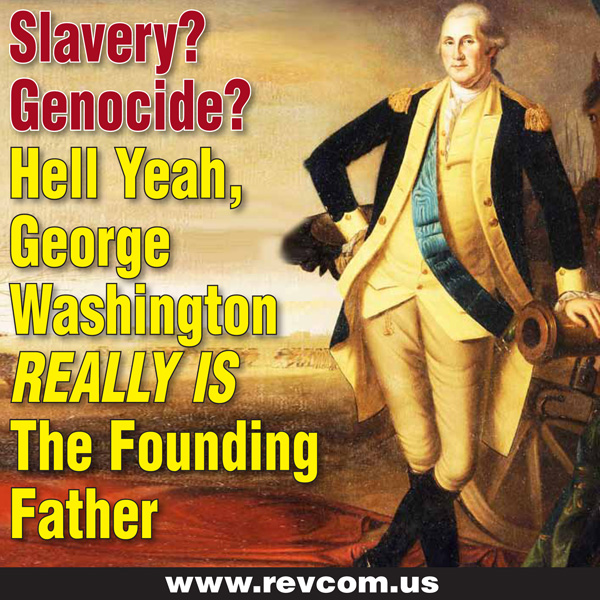
Get a free email subscription to revcom.us:


